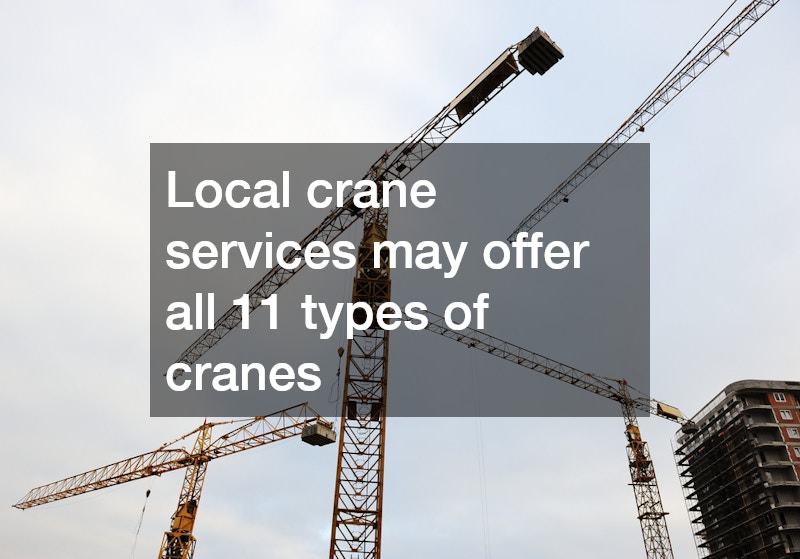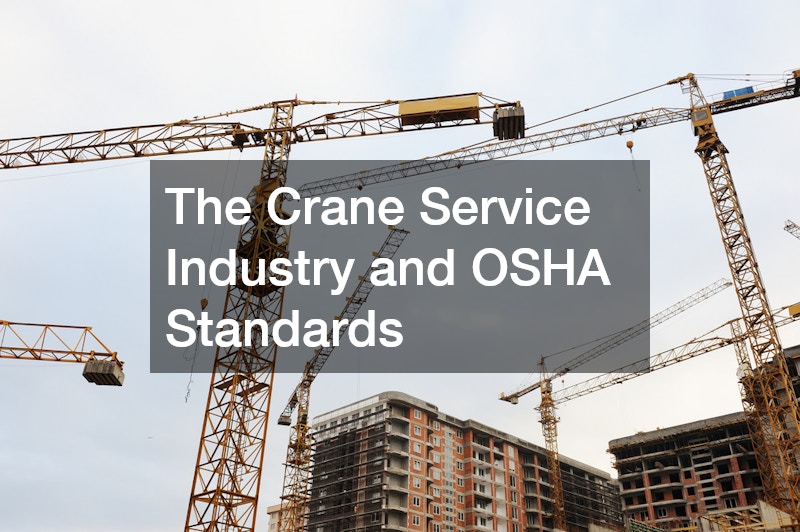
Many construction and industrial operations need to rent or hire a crane service. If you think of cranes only in terms of the tall, fixed cranes on skyscraper construction sites, think again. While local crane companies don’t always carry every type of crane, with some research, you can typically find a company that provides the kind you need to rent.

Types of Crane and Lifting Services
In major metropolitan areas, local crane services may offer all 11 types of cranes. What might these larger rental and sales companies provide?
• Bridge/overhead crane with variants including gantry and jib cranes
• Bulk-handling crane
• Carry deck cranes
• Crawler crane
• Floating crane
• Hammerhead crane
• Rough terrain crane
• Stacker Crane
• Telescopic crane
• Tower crane
• Truck-mounted crane.
Construction jobs frequently use rough terrain cranes, while large commercial operations frequently use carry deck cranes for accessing and moving items in warehouses.
Renting a Crane
Rental agreements vary, so your local crane service may offer daily, weekly, monthly, or long-term rentals. While some businesses require the use of a crane every day, these companies typically purchase the equipment. A new construction firm could rent needed cranes to save money and take larger jobs to grow their business.
Is your company in need of crane rental services? It’s essential to get answers to your questions and find the crane rentals that are right for you. One helpful resource is a crawler crane parts diagram, which can give you a better understanding of the equipment’s components.

When considering crane rentals, you might encounter issues related to crane classification and other common concerns. This is where expert guidance comes in handy. You can learn about crane legs and supports, crane tools and accessories, and other crucial aspects from your local pros.
Your local experts can help you select the most suitable crane for your specific project requirements. They’ll provide valuable insights into crane classification, ensuring that you get the right equipment with the necessary capacity and features to get your work done safely and efficiently.
So, if you’re in the market for crane rental services, don’t hesitate to reach out to your local pros. They’ll assist you in navigating the complexities of crane selection, addressing any questions or concerns you may have, and providing you with the tools and knowledge needed for your industry.

When you’re planning to provide crane service that utilizes hoisting or rigging equipment, it’s necessary to complete OSHA fall protection training and certification, crane training and certification, and rigging training and certification. Once you’ve completed your training and obtained the necessary certifications, you will have the opportunity to gain more valuable knowledge and experience while on the job.
An integral aspect of providing crane service includes following industry and job specific safety procedures. In addition to operating equipment properly, it’s necessary to have the skill set to determine when the equipment is in optimum condition and when it needs servicing.
There are different types of rigging and lifting equipment with which you will become familiar. Slings, for example, are commonly used for various types of material handling.
There are different types of slings, such as single, two, three or four leg. Depending on how often you use these slings, they should be inspected at different intervals. When slings undergo normal use, inspecting them on a yearly basis should be sufficient. However, when they sustain severe use, then they should be inspected on a monthly or quarterly basis.
https://www.youtube.com/watch?v=RXO6zSwfkqE
If you’re utilizing metallic core wire rope slings, it’s important to follow the manufacturer’s guidelines for usage and maintenance needs. Regardless of the sling’s grade, this is particularly important when working at temperatures below minus 40 degrees Fahrenheit and/or above 400 degrees Fahrenheit. When working with temperatures of up to 550 degrees Fahrenheit, uncoated metal mesh slings have been demonstrated to hold up to these temperatures.
Currently, OSHA requires that wire rope slings have permanent identification tags and labels. Additional information on this is provided in OSHA 1910.164.
Socket and clip fittings are used to attach the rope to a sling, and the type of fittings used will determine the load’s limit. This is because these essential pieces of equipment need to withstand 75% to 100% of the rope’s breaking point.
After you’ve been on the job for some time and have gained valuable experience, it’s still important to maintain and update your certifications. Due to OSHA’s three step process, to plan, provide, and train, accidents are being prevented. Even more important, lives are being saved as a result of these measures.

